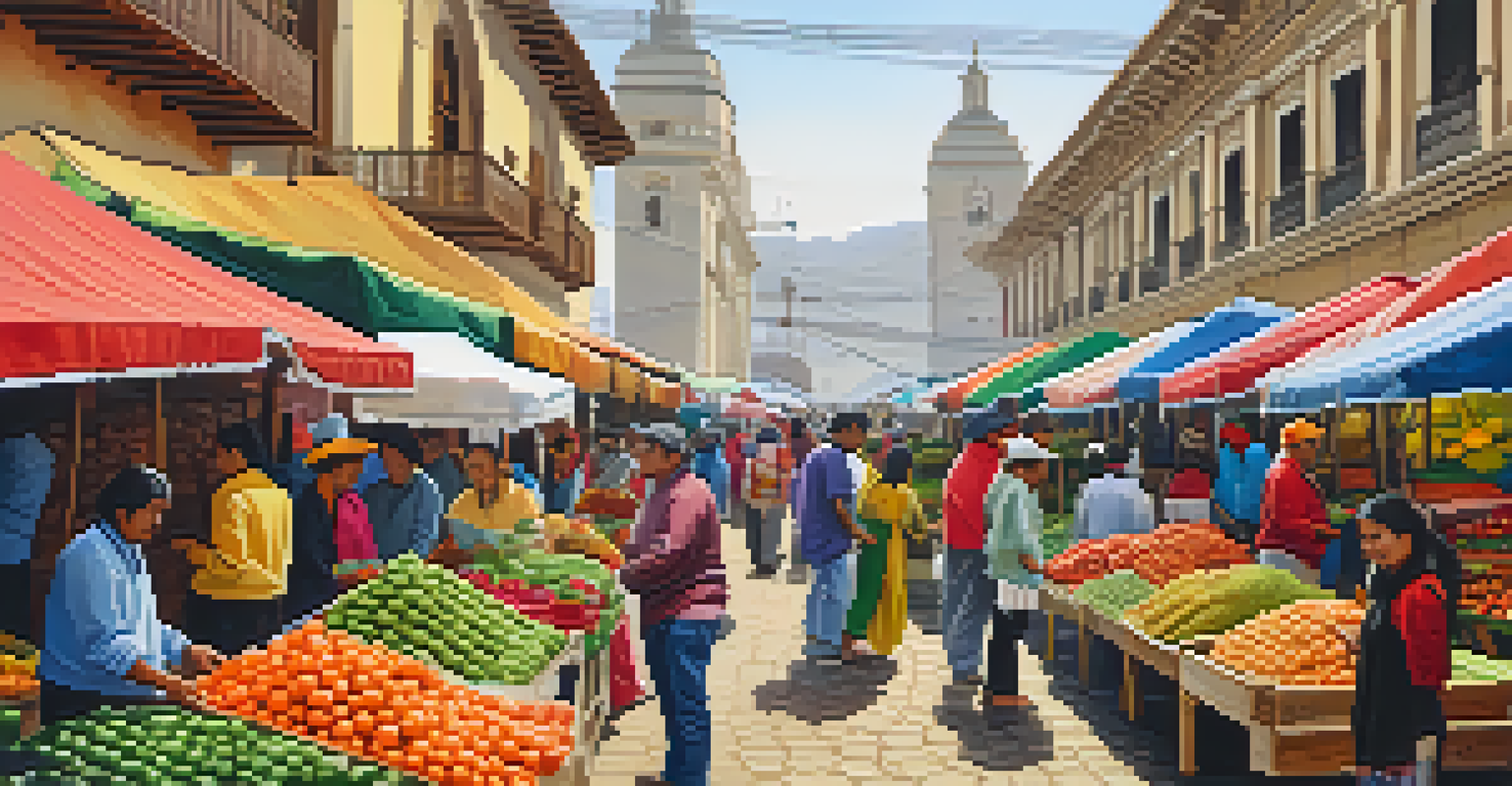Peru's Strategic Location: A Gateway for Global Trade Routes

Understanding Peru's Geographical Advantages
Peru is situated on the western edge of South America, with a vast coastline along the Pacific Ocean. This prime location not only gives it access to major shipping routes but also connects it to vital markets in Asia, North America, and beyond. The country's diverse geography, which includes mountains, deserts, and forests, adds to its strategic value by enabling various transportation methods.
Trade is a bridge that connects nations and fosters global cooperation.
The Pacific port cities, such as Callao, serve as critical gateways for international trade. These ports facilitate the export of Peru's rich natural resources, including minerals and agricultural products, making them essential for the global supply chain. Additionally, the connection to the Andes allows for efficient inland transportation of goods to and from the interior regions.
Peru's location also offers opportunities for trade agreements with neighboring countries. By participating in regional trade blocs and agreements, such as the Pacific Alliance, Peru enhances its position as a trading hub, promoting economic growth and integration within the region.
Historical Context of Peru as a Trade Hub
Historically, Peru has been a meeting point for various civilizations, such as the Incas and Spanish colonizers, which laid the foundation for its trade networks. The Incan Empire thrived on trade across the Andes, exchanging goods and resources among different regions. This legacy of commerce continues to influence modern trade practices in Peru.

During colonial times, Lima emerged as a key port for Spanish trade in the Americas, connecting Europe with the rich resources of South America. This historical significance has left an indelible mark on Peru's trade policies and infrastructure development. Today, the modern ports still echo this bustling trade activity, showcasing the long-standing importance of Peru in global commerce.
Peru's Strategic Geographic Location
Peru's prime location along the Pacific coast enhances its access to global markets and trade routes, making it a key player in international commerce.
Understanding this historical context helps us appreciate how Peru's strategic location has been leveraged over centuries. The evolution of trade in Peru highlights its resilience and adaptability in a rapidly changing global landscape.
Key Trade Routes and Their Impact on Peru
Peru's location allows it to be a pivotal point for several major trade routes. The Pacific Ocean route connects Peru to key markets in Asia, especially China, which is one of its largest trading partners. This direct maritime route significantly reduces shipping times and costs, benefiting both exporters and importers.
Geography is destiny; it shapes our economy, our politics, and our culture.
Additionally, land routes through the Andes facilitate trade with Brazil and other neighboring countries. These overland connections are vital for the movement of goods such as agricultural products and manufactured items. By linking with larger economies, Peru enhances its economic prospects and strengthens regional ties.
The impact of these trade routes is profound, as they not only boost Peru's economy but also create job opportunities for its citizens. As trade flourishes, so does the potential for innovation and development in various sectors, from agriculture to technology.
Peru's Role in the Global Supply Chain
As a key player in the global supply chain, Peru exports a wide array of goods, including minerals, textiles, and agricultural products like avocados and quinoa. These exports are critical to meeting the demands of international markets, showcasing Peru's unique resources. The country's agricultural sector, in particular, has seen significant growth due to its strategic location and favorable climate.
Furthermore, Peru's involvement in the supply chain extends beyond exports to include imports of essential goods and technologies. This exchange not only helps diversify its economy but also supports local industries by providing access to the latest innovations. By participating in this global network, Peru is positioning itself as a forward-thinking economy.
Historical Trade Significance
The legacy of historical trade networks, from the Incan Empire to colonial times, continues to influence Peru's modern trade practices and policies.
The integration into global supply chains also enhances Peru's competitiveness. As businesses adapt to international standards and practices, they improve their efficiency and quality, ultimately benefiting consumers both locally and abroad.
Trade Agreements and Economic Growth
Peru has actively pursued trade agreements that bolster its position as a global trade hub. Agreements with countries like the United States, Canada, and members of the European Union have opened up new markets for Peruvian products. These partnerships have proven beneficial for both sides, fostering economic growth and creating a more stable trading environment.
Through these agreements, Peru has gained preferential access to various markets, which boosts exports significantly. This accessibility encourages local businesses to expand and innovate, knowing they have a ready market for their goods. Consequently, the Peruvian government has focused on promoting policies that facilitate trade and attract foreign investment.
These strategic partnerships not only enable economic growth but also improve Peru's global standing. As the country embraces trade liberalization, it positions itself as an attractive destination for investors and businesses looking to tap into South America's resources and markets.
Challenges Facing Peru's Trade Sector
Despite its strategic advantages, Peru's trade sector faces several challenges. Infrastructure development remains a critical issue, as inadequate transportation and logistics can hinder trade efficiency. The government has recognized this and is working to enhance infrastructure, but progress takes time and significant investment.
Additionally, political and economic instability can impact trade relationships. Changes in government policies or economic downturns can disrupt established trade agreements and create uncertainty for investors. Building a stable environment is essential for maintaining and growing trade partnerships.
Challenges and Future Potential
Despite facing challenges like infrastructure issues and regional competition, Peru's commitment to trade agreements and sustainability positions it for future growth.
Moreover, competition from other countries in the region poses a threat to Peru's trade aspirations. Countries like Chile and Colombia are also vying for a share of the global market, making it crucial for Peru to continuously innovate and improve its offerings.
The Future of Peru as a Trade Gateway
Looking ahead, Peru's potential as a trade gateway appears promising. With ongoing investments in infrastructure and trade agreements, the country is poised to enhance its role in global commerce. The government is committed to creating a favorable business environment that attracts foreign investment and supports local enterprises.
Sustainability is also becoming a focal point for Peru's trade strategy. By prioritizing environmentally friendly practices and sustainable resource management, Peru can appeal to conscious consumers and businesses worldwide. This shift not only benefits the environment but also positions Peru as a leader in sustainable trade.

As Peru continues to adapt to global trends, its strategic location will remain a vital asset. By harnessing its geographical advantages and fostering strong trade relationships, Peru is setting the stage for a vibrant future in international trade.